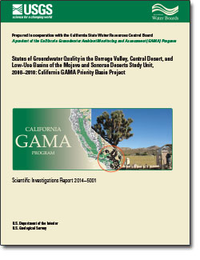Status of groundwater quality in the Borrego Valley, Central Desert, and Low-Use Basins of the Mojave and Sonoran Deserts study unit, 2008-2010: California GAMA Priority Basin Project
Links
- More information: USGS Index Page
- Document: Report
- Related Work: Related Work
- Download citation as: RIS | Dublin Core
Abstract
Groundwater quality in the approximately 963-square-mile Borrego Valley, Central Desert, and Low-Use Basins of the Mojave and Sonoran Deserts study unit was investigated as part of the Priority Basin Project of the Groundwater Ambient Monitoring and Assessment (GAMA) Program. The study unit is located in southern California in San Bernardino, Riverside, San Diego, and Imperial Counties. The GAMA Priority Basin Project is being conducted by the California State Water Resources Control Board in collaboration with the U.S. Geological Survey and the Lawrence Livermore National Laboratory.
The GAMA Borrego Valley, Central Desert, and Low-Use Basins of the Mojave and Sonoran Deserts study was designed to provide a spatially unbiased assessment of the quality of untreated (raw) groundwater in the primary aquifer system. The assessment is based on water-quality and ancillary data collected by the U.S. Geological Survey from 52 wells (49 grid wells and 3 understanding wells) and on water-quality data from the California Department of Public Health database. The primary aquifer system was defined by the depth intervals of the wells listed in the California Department of Public Health database for the Borrego Valley, Central Desert, and Low-Use Basins of the Mojave and Sonoran Deserts study unit. The quality of groundwater in the primary aquifer system may be different from that in the shallower or deeper water-bearing zones; shallow groundwater may be more vulnerable to surficial contamination.
This study assesses the status of the current quality of the groundwater resource by using data from samples analyzed for volatile organic compounds (VOCs), pesticides, and naturally occurring inorganic constituents, such as major ions and trace elements. This status assessment is intended to characterize the quality of groundwater resources in the primary aquifer system of the Borrego Valley, Central Desert, and Low-Use Basins of the Mojave and Sonoran Deserts study unit, not the treated drinking water delivered to consumers by water purveyors.
Relative-concentrations (sample concentration divided by the health- or aesthetic-based benchmark concentration) were used for evaluating groundwater quality for those constituents that have Federal or California regulatory or non-regulatory benchmarks for drinking-water quality. A relative-concentration greater than 1.0 indicates a concentration greater than a benchmark, and a relative-concentration less than or equal to 1.0 indicates a concentration equal to or less than a benchmark. Relative-concentrations of organic constituents and special-interest constituents [perchlorate and N-nitrosodimethylamine (NDMA)] were classified as high (relative-concentration greater than 1.0), moderate (relative-concentration greater than 0.1 and less than or equal to 1.0), or low (relative-concentration less than or equal to 0.1). Relative-concentrations of inorganic constituents were classified as high (relative-concentration greater than 1.0), moderate (relative-concentration greater than 0.5 and less than or equal to 1.0), or low (relative-concentration less than or equal to 0.5).
Aquifer-scale proportion was used as the primary metric in the status assessment for evaluating regional-scale groundwater quality. High aquifer-scale proportion is defined as the percentage of the area of the primary aquifer system with a high relative-concentration for a particular constituent or class of constituents; this percentage is based on an areal rather than a volumetric basis. Moderate and low aquifer-scale proportions were defined as the percentages of the primary aquifer system with moderate and low relative-concentrations, respectively, of a constituent or class of constituents. Two statistical approaches—grid-based and spatially weighted—were used to evaluate aquifer-scale proportions for individual constituents and classes of constituents. Grid-based and spatially weighted estimates were comparable to each other (within 90-percent confidence intervals) in the study unit.
Inorganic constituents (one or more) with health-based benchmarks were detected at high relative-concentrations in 48 percent of the primary aquifer system and at moderate relative-concentrations in 26 percent of the primary aquifer system. The high aquifer-scale proportion of inorganic constituents primarily reflected high aquifer-scale proportions of fluoride (27 percent), arsenic (18 percent), molybdenum (16 percent), boron (10 percent), uranium (5.6 percent), gross alpha radioactivity (9.7 percent), and nitrate (2.7 percent). The inorganic constituents with secondary maximum contaminant levels (SMCLs) were detected at high relative-concentrations in 13 percent of the primary aquifer system and at moderate relative-concentrations in 39 percent. The high aquifer-scale proportion for SMCL constituents reflected high aquifer-scale proportions of total dissolved solids (TDS, 11 percent), manganese (2.8 percent), and chloride (2.8 percent).
Organic constituents were not detected at high relative-concentrations in the primary aquifer system, and were present at moderate relative-concentrations in 5.0 percent, and at low relative-concentrations or were not detected in 95 percent of the primary aquifer system. Of the 148 organic constituents analyzed, 12 constituents were detected. Two organic constituents, chloroform and tetrachloroethene (PCE), were detected in more than 10 percent of samples, but were detected mostly at low relative-concentrations.
Study Area
| Publication type | Report |
|---|---|
| Publication Subtype | USGS Numbered Series |
| Title | Status of groundwater quality in the Borrego Valley, Central Desert, and Low-Use Basins of the Mojave and Sonoran Deserts study unit, 2008-2010: California GAMA Priority Basin Project |
| Series title | Scientific Investigations Report |
| Series number | 2014-5001 |
| DOI | 10.3133/sir20145001 |
| Year Published | 2014 |
| Language | English |
| Publisher | U.S. Geological Survey |
| Publisher location | Reston, VA |
| Contributing office(s) | California Water Science Center |
| Description | viii, 88 p. |
| Country | United States |
| State | California |
| County | Imperial County;Riverside County;San Bernardino County;San Diego County |
| Other Geospatial | Borrego Valley;Mojave Desert;Sonoran Desert |
| Projection | Albers Equal Area Conic Projection |
| Online Only (Y/N) | N |
| Additional Online Files (Y/N) | N |


